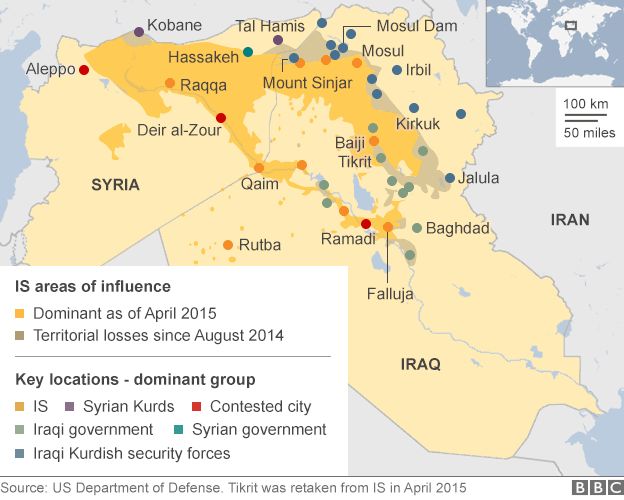The military strategy behind IS conquests
- 16 June 2015
- From the section Middle East

A
year on from Abu Bakr al-Baghdadi's declaration of a caliphate, Islamic
State (IS) remains a powerful battlefield force, despite thousands of
air strikes launched against it by the United States and its allies.
The
stated aim of the aerial campaign was, in the words of US President
Barack Obama, to "degrade and ultimately destroy" the Islamic State.
However, if anything IS has shown surprising resilience and emerged more
battle-hardened. An analysis of their military strategy helps to explain why. At its core is the concept of "Remaining and Expanding", enunciated in the group's propaganda magazine Dabiq in November 2014.
Putting theory into practice, IS has remained in its putative capital Raqqa in Syria and in Mosul, Iraq's second largest city. And just last month it expanded, seizing Ramadi, the capital of Iraq's Anbar province, and the strategic Syrian town of Palmyra.
Three rings
The ultimate aim of Islamic State is global domination.Toward that end it has divided the world into what the Institute for the Study of War (ISW), a Washington-based think tank, notes are "three geographic rings: the Interior Ring in Iraq and al-Sham (Syria), the Near Abroad in the wider Middle East and North Africa, and the Far Abroad in Europe, Asia and the United States."
All three have been used to good effect in the Interior Ring.
In the Near Abroad, the impact of conventional and guerrilla war by IS affiliates is being felt, with numerous attacks on the military and police in Egypt's Sinai and the seizure of several towns in Libya, including the former Gaddafi stronghold of Sirte.
Meanwhile, so-called "lone wolves" have brought terror tactics to the Far Abroad, with IS taking credit for attacks in Australia, the US and Canada.
'Belt Strategy'
In Iraq and Syria, tactics such as the use of Vehicle Born Improvised Explosive Devices (VBIEDS), essentially suicide bombs on wheels, many of them US-built Humvees captured from fleeing Iraqi forces, have proved highly successful battlefield weapons.Added to this are the droves of individual suicide bombers deployed both when attacking and when under attack.
Larger cities are taken by a combination of infiltration, particularly into disenfranchised Sunni communities in Iraq and through what the ISW study calls the Belt Strategy: "A way to organise a battle plan around a principle city using dispersed units, informal tactics and freedom of manoeuvre to compromise the main defences of a conventional enemy."
In this strategy first towns and villages surrounding large urban centres are taken, closing roads, and creating a belt of encirclement. The belt is tightened as IS draws closer and begins to take control of the suburbs.
Diversion tactics
IS uses the huge desert regions of both Syria and Iraq to its advantage, withdrawing into them and emerging from them almost at will, aided by a high degree of mobility and an organisational efficiency that keeps its soldiers in the field well supplied with both ammunition and water.And although the allied air attacks have disrupted large scale desert movement of troops and vehicles, IS has responded by breaking its forces into smaller, less detectable units.
Thus, a relatively small number of jihadists can occupy a much larger force while their fellow fighters are attacking a strategic town, army base or other key installation such as a dam or oil refinery.
Against that backdrop, the defence of the Syrian town of Kobane and the retaking of Tikrit in Iraq remain modest battlefield achievements.
For as the world is only now beginning to acknowledge, IS is a formidable, highly motivated and disciplined fighting force. More than that it is an organisation with a well thought out, systematically structured and well proven battlefield strategy.
Compare that to President Obama's recent admission that, after one year of war "we do not yet have a strategy to defeat ISIS [Islamic State]" and the full weight of the challenge ahead becomes ominous indeed.
Bill Law is a Middle East analyst and a specialist in Gulf affairs. Follow him @BillLaw49

ไม่มีความคิดเห็น:
แสดงความคิดเห็น